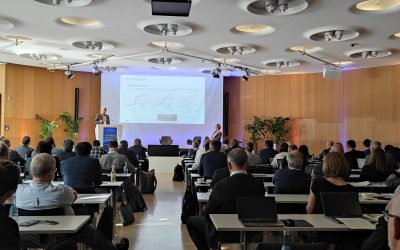Using standards and creating new ones is essential for turning innovations into real market success and making industry more sustainable in the long term. Many studies clearly show how important this is. Anyone developing new technologies, materials, or applications can benefit greatly from standards. In fact, using them can be a key factor in whether an innovation thrives or fails. Although there’s no fully mature set of standards specifically for Rare Earth‑free Permanent Magnets (RE-Free PMs), some related shifts are underway. For example, the Critical Raw Materials Act[1] in the EU is pushing for reduced dependency on rare earths, broader material substitution, and will most likely incentivize standards and certification related to RE‑free options.
This intelligence bulletin aims to shed light on the current standardisation activities related to permanent magnets and to identify potential opportunities for the development of standards addressing rare-earth-free permanent magnets.
Introduction to Standardisation
Standards are technical specifications, agreed by the relevant stakeholders, subject to voluntary use, which are published by a recognized standardisation organisation.
Standards are a market intelligence tool for companies and SMEs, a quality tool for societal stakeholders and a tool for the deployment of regulations and policies for public authorities. Existing studies present standards as a catalyser of trade, and they are present in a significative percentage of the world commerce exchanges. According to the Public Procurement Directive[2], they can be cited as technical specifications in public procurements procedures. They can also be used as a reference in technical regulation and legislation. As an example, the so-called “harmonised standards” are the most practical and fast way to comply with the requirements of European Directives.
Standardisation is the process of drafting, agreement, and publication of standards. It is open to all interested parties, including companies, SMEs, universities, research institutes, associations, NGOs, public authorities, etc.
According to the European Industrial Strategy[3] and the European Green Deal[4], standardisation plays a crucial role in the sustainability and competitiveness of European industry. This is also acknowledged in the EU Strategy on Standardisation[5], focusing on the benefits of raising new standards from innovative knowledge. Companies and SMEs can be favoured from being the tractors of new standards covering their innovations, or some aspects of them, to protect their market expectations by creating confidence in customers, avoid barriers and leading the definition of new requirements instead of adapting their production practices and equipment to comply with external ones. Therefore, participation in standardisation activities should be a part of the commercial and exploitation strategy of companies, universities and research organisations.
STANDARDISATION AND PERMANET MAGNETS
Permanent magnets (especially rare earth permanent magnets like NdFeB, SmCo) are critical enablers of green technologies (EVs, wind turbines, electric motors, generators, consumer electronics, etc.). However, growing geopolitical risk, environmental concerns, supply chain fragility, and regulatory pressure are reshaping their landscape.
PASSENGER (Pilot Action for Securing a Sustainable European Next Generation of Efficient RE-free Magnets) is developing an innovative way to produce permanent magnets without rare-earth materials and is piloting the new magnets in the electromobility sector.
Rare‐earth‐free permanent magnets are magnetic materials that do not use (or use minimal) rare earth elements (REEs) like Neodymium (Nd), Praseodymium (Pr), Dysprosium (Dy), Terbium (Tb), etc. They typically rely on materials such as:
- Ferrites (e.g. strontium ferrite, barium ferrite)
- Manganese‑based magnets (e.g. Mn‑Bi)
- Other transition metal compounds (e.g. cobalt, FeNi, etc.)
- New composite / hybrid materials or enhancement of traditional ferrites through nano‑structuring, improved sintering, etc.
These RE‑free magnets generally offer lower maximum energy product (BH_max), possibly lower thermal stability or coercivity under some conditions than the best rare‐earth magnets; but they have big advantages in cost, supply risk, sustainability, and environmental footprint.
At present, the standardisation around permanent magnets tends to focus on materials which include rare earths (especially NdFeB, SmCo) or ferrite (which is RE‑free) but often as a lower grade class. The move toward new RE‑free materials reveals several gaps and emerging needs.
Existing standards covering Premanent Magnets
| Standard Body | Published Standards | Standards under development |
| IEC/ TC 68 “Magnetic alloys and steels” |
• IEC 60404-5:2015 — “Magnetic materials – Part 5: Permanent magnet (magnetically hard) materials – Methods of measurement of magnetic properties” • IEC 60404 8 1:2023 — “Magnetic materials – Part 8-1: Specifications for individual materials — Permanent magnet (magnetically hard) materials”. • IEC 60404 18:2025 — “Magnetic materials – Part 18: Permanent magnet (magnetically hard) materials – Methods of measurement of the magnetic properties in an open magnetic circuit using a superconducting magnet”. • IEC TR 62517:2009 — “Magnetizing behaviour of permanent magnets”. |
• IEC 63311 ED1 — “Permanent magnet (magnetically hard) materials – Method of measurement based upon the pulsed field magnetometry (PFM) technique” |
| ISO/TC 298 Rare earth |
• ISO 17887:2025 — “Traceability of rare earths in the supply chain from separated products to permanent magnets” |
• ISO/CD 24457— “Specifications for short loop recycling of neodymium iron boron sintered permanent magnets” • ISO/PWI 26023 — “Classification and labeling of sintered NdFeB permanent magnets for traceability of rare earth” |
| CEN/TC 472 Rare Earth Elements | • FprCEN/TS 18263 — “Permanent magnet products – Procedure for declaring recycling-relevant information” |
STANDARDISATION CHALLENGES AND OPPRTUNNITIES FOR RE-FREE PERMANET MAGNETS
In the field of standardisation, some progress has been made regarding permanent magnets, although the path is still at an early stage. However, for rare-earth-free permanent magnets, virtually no standardisation work has yet been undertaken.
Most of the ongoing developments related to permanent magnets concern testing methods, measurement techniques, traceability, and terminology – in other words, the supporting infrastructure. While these efforts do not currently encompass rare-earth-free permanent magnets, they are nonetheless valuable: before a material can be claimed to be “rare-earth-free,” agreed testing methods must exist to verify that its content falls below the defined thresholds.
For rare-earth-free permanent magnets, there remains a wide and largely unexplored area for standardisation. Advancing in this direction represents both a significant challenge and an important opportunity to address a field with strong future potential.
Some aspects that could be subject to standardisation include:
- Performance Benchmarks for Novel RE‑Free Materials
Many new RE‑free materials have not yet been fully validated over temperature, mechanical stress, long‑term ageing etc. Standards may not yet exist that cover such performance for these new materials.
- Measurement Methods Adapted to lower performance materials
Some test methods are optimised for high energy magnets (with rare earths). RE‑free magnets (especially ferrites, MnBi, composites) might require adapted protocols, tolerances, calibration.
- Material / Composition Definitions
Existing standards define ferrite magnet types, classes etc. But for less common alloys (like MnAlC etc.), there’s a lack of standardized definitions or property class descriptions.
- Design for Use / Application Performance
Motors and other devices using RE‑free magnets need standardisation for how magnets are integrated (mounting, bonding, assembly) to ensure mechanical stability, thermal management, demagnetization risk etc.
- Environmental & Sustainability / Life‑Cycle / Eco‑Labelling
There is increasing pressure to evaluate environmental impacts (mining, processing, emissions, recycling). Standards for life‑cycle assessment, carbon footprint, recyclability etc. are still underdeveloped specifically for RE‑free magnets.
WHAT TO MONITOR MOVING FORWARD
To stay ahead of developments in rare-earth-free permanent magnets and the evolving standardisation landscape in this area, stakeholders should closely monitor developments in draft standards or working group formations that specifically call for rare earth-free or rare earth-reduced magnets.
Traditionally, standardisation has focused on areas already well established in the market, aiming to address issues related to trade, interoperability, or safety. However, standards are increasingly being employed as tools to promote the market adoption of innovative technologies.
Standards can be found on the searching engines for the catalogues of the Standardisation Organisations, accessible through:
- the CEN standards search engine
- the CENELEC standards search engine
- the ISO standards search engine
- the IEC standards search engine
The use of standardisation as a track to valorise research and innovation results is emphasized in the ‘EU Policy on Knowledge Valorisation’ (Council Recommendation (EU) 2022/2415) and the ‘Code of Practice on Standardisation in the EU research area’ (Commission Recommendation (EU) 2023/498), making special emphasis on Horizon Europe projects but also to other, public- or private-funded innovation results.
[1] Regulation (EU) 2024/1252 of the European Parliament and of the Council of 11 April 2024 establishing a framework for ensuring a secure and sustainable supply of critical raw materials and amending Regulations (EU) No 168/2013, (EU) 2018/858, (EU) 2018/1724 and (EU) 2019/1020 (Text with EEA relevance), see https://eur-lex.europa.eu/legal-content/EN/TXT/?uri=OJ:L_202401252
[2] Directive 2014/24/EU of the European Parliament and of the Council of 26 February 2014 on public procurement and repealing Directive 2004/18/EC, see https://eur-lex.europa.eu/legal-content/es/TXT/?uri=CELEX:32014L0024
[3] COMMUNICATION FROM THE COMMISSION TO THE EUROPEAN PARLIAMENT, THE EUROPEAN COUNCIL, THE COUNCIL, THE EUROPEAN ECONOMIC AND SOCIAL COMMITTEE AND THE COMMITTEE OF THE REGIONS A New Industrial Strategy for Europe COM/2020/102 final https://eur-lex.europa.eu/legal-content/EN/TXT/?uri=CELEX%3A52020DC0102
[4] COMMUNICATION FROM THE COMMISSION TO THE EUROPEAN PARLIAMENT, THE EUROPEAN COUNCIL, THE COUNCIL, THE EUROPEAN ECONOMIC AND SOCIAL COMMITTEE AND THE COMMITTEE OF THE REGIONS The European Green Deal COM/2019/640 final https://eur-lex.europa.eu/legal-content/EN/TXT/?uri=COM%3A2019%3A640%3AFIN
[5] COM(2022) 31 final COMMUNICATION FROM THE COMMISSION TO THE EUROPEAN PARLIAMENT, THE COUNCIL, THE EUROPEAN ECONOMIC AND SOCIAL COMMITTEE AND THE COMMITTEE OF THE REGIONS An EU Strategy on Standardisation Setting global standards in support of a resilient, green and digital EU single market DocsRoom – European Commission (europa.eu)




